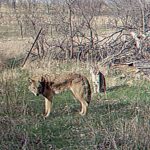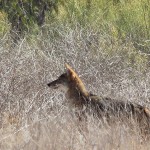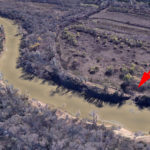Mange is a skin disease that occurs in some North Texas mammals–both wild and domestic. It is a terrible affliction, especially for wild animals with no recourse. Of all the wild animals that call North Texas home, it is most often Coyotes we find suffering from this dreadful condition.
The disease is of interest because there are lots of Coyotes living among us–more than most people expect. We share our cities and suburbs with Coyotes all across the country, and these wild canines are well adapted to urban survival. There are thousands of them living with us here in Dallas/Fort Worth alone. Coyotes can be found present and thriving in almost every North Texas neighborhood. And because of the pervasiveness of Coyotes in our urban areas, it can be difficult to ignore the impact mange has on these animals.

Mange develops gradually in Coyotes. Early symptoms are not always explicit, but they are always foreboding. The condition is relentless in its progression, and a great deal of pain and suffering await an afflicted Coyote. Animals with advanced cases of mange will often be in grotesque condition, and clearly in much misery. For most Coyotes with the disease, a long, drawn-out death is the only escape.

No one–not even people who do not prefer Coyotes–yearn to have animals suffer through the cruel fate mange exacts. Some folks are so dismayed at the suffering of these animals, that they desire to do something to help. And, while treating and curing Coyotes with mange is possible, it is not an easy undertaking–especially with existing techniques. Furthermore, current methods for treating mange in Coyotes address only individual animals. There is no effective way to medicate whole populations prophylactically in order to prevent mange outbreaks in the first place.
A broad treatment protocol that could be used to treat large numbers of infected Coyotes–and even prevent the illness entirely–is what is really called for. But with the limitations of current medicines and delivery techniques, it is hard to imagine how something like this could be accomplished. What we need is a better method.

causes mange in Coyotes
In this article, we are going to explore one such possibility. This thought exercise may prove to be largely just an indulgence in daydreaming. We will be considering things that may be feasible soon, rather than advocating for an immediately practical solution. Much of what is going to be proposed here will likely never come to pass; there would need to be some dramatic shifts in priorities for these ideas to ever be pursued seriously. Still, there is no harm in conceptualizing a new approach, even if it proves to be idealistic.
But first, let’s establish exactly what were are talking about here. Sarcoptic Mange is the specific name of the disease that afflicts Texas Coyotes. The disease is caused by an infestation of Sarcoptes scabiei, a tiny parasitic mite that burrows into the skin of a host Coyote. The canis variety of this mite can complete its entire lifecycle on a canine host, so once an Coyote is infected the disease will be chronic, without some kind of intervention.
The immune system response to an Sarcoptic Mange infection is inflammation and unrelenting itching. The symptoms are so severe that an afflicted animal will bite and scratch themselves raw. An infected Coyote will soon develop hairless patches, often with open and bleeding wounds. As the disease progresses, the affected animal may be entirely denuded of fur, leaving it’s diseased, leathery skin completely exposed to the elements. At this stage the disease is almost always fatal, as the Coyote will only become more and more vulnerable to secondary infections and extreme weather conditions going forward.

Click to Enlarge
Mange is contracted and spread primarily through close contact, and the sharing of dens and bedding areas. Because Coyotes are family-oriented and social animals, once one member of a group becomes infected, it is a virtual certainty that the entire family will succumb as well–a development that will likely seal the fate of them all.

Mange seems to affect urban Coyotes disproportionally. Many believe that this is due to the concentrated use of rodenticides in our more developed areas. It is thought that Coyotes develop secondary poisoning by consuming poisoned rats and mice. Often the level of secondary poisoning is not enough to kill the Coyote, but it is sufficient to have a negative impact on the Coyote’s immune system. Coyotes with depressed immune systems are thought to then become more susceptible to mange infestations.
Mange begins when an individual animal becomes infested with the mites that are responsible for the disease. Early outward signs of an infection are patches of ratty-looking or missing fur on the Coyote’s body. Hair on the tail is often the first to go, as Coyotes can readily bite at the affected area. Later, furless patches in other places on the animal will develop–frequently becoming raw with sores and bleeding–due to the never ending scratching the disease compels.

Eventually, as the disease progresses, an afflicted Coyote may become completely denuded of fur. Raw, thickened, and blackened skin is left completely exposed to intense sun or extreme cold. At this stage of the disease–with no protection from the elements–the outcome is inevitable. The first brutal cold snap of the season will almost certainly be fatal for the Coyote, if an infection does not do in the poor animal first.

Remarkably, some resourceful and particularly resilient Coyotes can find ways to persevere for a time. Sunbathing on balmy days can offer some relief from the itching, and a good den or shelter can help a Coyote survive extreme weather. Living in an area that can provide abundant food and good nutrition can aid in survival as well. Some of these tenacious Coyotes can survive for years in spite of the disease, but it must be a truly miserable existence to endure.
Coyotes at the end stage of the disease frequently become so sick and distressed that all they can do is wander aimlessly, lost in the stupor of their misery. In this condition, many lose interest in securing food, and become less concerned about danger. All they seek is just a moment of relief from the never-ending discomfort. It’s very heart-rending to see Coyotes in this condition. The misery they feel is palpable.

As mentioned earlier, there are medications available that can be used to treat, and sometimes cure, Coyotes with mange. But, treating Coyotes with mange is not a trivial undertaking. Unfortunately, there are a number of serious difficulties that must be overcome to successfully help Coyotes with this disease.
Perhaps the most pressing challenge is delivering proper doses of medication to only the animals that need it. This can be a very difficult proposition in many cases, and there are a number of reasons why. A few years ago we did a write-up that details the troubles to be expected when attempting to medicate Coyotes with mange, and why success is so elusive. You can learn more by following the link below…
ARTICLE – Why it’s Challenging to Treat Coyotes with Mange
Suffice it to say, that traditional techniques for treating mange in Coyotes are somewhat lacking. The weak link in the treatment protocol is the need for intimate human involvement over a long period of time. In most cases, around the clock monitoring and close interaction are the only ways to insure effective dosing. Much time and effort is required to insure that medication is delivered to the correct animal and in the proper doses.
Currently, Coyotes are treated on a case-by-case basis. Only animals in the right situation to be addressed by properly equipped wildlife rehabbers will have a chance to be medicated and cured–the majority of sick Coyotes will never get help. And no matter what, current methods for addressing mange in Coyotes will never be a practical way to broadly control and prevent the disease in the general population. A new approach is called for.
This is where we are going to begin considering somewhat immoderate and ambitious possibilities. It seems conceivable that an automated bait station, enabled with artificial intelligence and a biometrics system, could handle around-the-clock medication dispensing in a way even the most dedicated person could not. It may be possible that an AI enabled system could overcome some–if not all–of the typical difficulties involved in treating Coyotes with mange.
The system might work something like this… Solar powered bait stations, enabled with artificial intelligence, would be installed in areas where afflicted Coyotes are known to frequent (or anyplace Coyotes might be present, if the objective includes prevention). The bait stations would be equipped with dispensers for medicated and unmedicated baits. Initially, the installation might release only untreated baits–on a regular schedule–in order to attract and habituate Coyotes to accessing the bait station. A system of motion-detecting cameras could be used to collect biometrics on the Coyotes that visit the installation. Pictures would be recorded from different vantage points in order to provide for the necessary data collection. Artificial Intelligence would be used to identify, and catalog individual animals based on the pictures recorded. AI analysis could ensure that only Coyotes received bait–treated and untreated–by denying baits to non-targeted species.

Click to Enlarge
Later, after the local population of Coyotes had been habituated to the bait station, baits would only be dispensed when a Coyote visited the installation, and only after the AI system determined its identity and treatment status. If a Coyote required medication, a treated bait would be released. Otherwise, an untreated bait would be provided to ensure the Coyote would continue to return to the station on a regular basis. Coyotes new to the area would be expected to recognize the bait station as a source of food by following the example of already habituated resident animals.

As the station compiled a catalog of visiting Coyotes, the integrated AI could make determinations about which animals were afflicted with mange, and keep track of their general health, their treatment regiment, and how each animal was responding to the therapy. Healthy Coyotes could be offered medicated bait on a regular schedule in order to prevent them from ever developing the disease. All of the information collected would be kept up-to-date in a cloud-hosted database.
A networked system of these kind of bait stations could be expected to address a large population of animals across sizeable areas. City parks and greenbelts would be natural choices for installations. AI enabled bait stations could be setup in various parts of an area of concern, and spaced out in a way that would provide comprehensive coverage. This would allow for an entire population of Coyotes to be treated prophylactically, potentially preventing outbreaks of the disease altogether.
The technology needed to develop bait stations enabled with artificial intelligence likely already exists. The cost to develop, procure, install, and maintain such specialized equipment would certainly be substantial–maybe even prohibitively high. The question would be whether the benefits could ever justify the expense.
The primary beneficiary of a program like the one described in this article would be almost exclusively the Coyotes, as the mange is not a serious problem for people, pets, livestock, or other wildlife species. People can be infected with sarcoptic mange, but the disease is only temporary and resolves on its own, since the mite cannot complete its life cycle on a human host. Other animals–including pets and other wild animals–can and sometimes do become infected with sarcoptic mange, but because the disease is usually transmitted via close contact, it remain almost exclusively a disease of Coyotes. Furthermore, the condition can be treated effectively in pets and livestock when it does occur.

The motivation for conducting a treatment program using one of these specialized bait station would primarily be altruistic–with the objective being simply to alleviate pain and suffering in sick Coyotes. But Coyotes are polarizing animals. Opinions about these animals vary widely–some people like them and others do not. Some folks see Coyotes as valuable members of the ecosystem, and some see them solely as vermin in need of extermination. Some people will want to help them, and others will have no interest. The divide will be difficult to bridge.
Alleviating the pain in suffering Coyotes with mange might be reason enough to develop and install systems like this, but the impractical economies of such a system makes the adoption of such a solution seem unlikely. It is hard to imagine a scenario that would motivate government entities to invest in a program of this kind.

As far as can be determined, there has never been an organized, large scale attempt–of any kind–to control and eradicate mange in Coyotes. This likely speaks volumes about how open governments and the general population would be to a new proposal to do so. That may mean that there will never be enough interest or public support to merit a concerted effort to treat mange in urban Coyotes.
But, who knows what the future might bring? That there even exists technology that allows for the consideration of a proposal like this is really a remarkable thing. Attitudes about animals can–and have–changed over time–that much is also certain. At some point unabashed altruism might win the day. Efforts intended to alleviate pain and suffering can be hard to argue against. Successful implementation of a system like the one described here has the potential to control or eliminate mange in the areas where it operated. If an installation could be demonstrated to be effective in a limited testbed situation, maybe people would become open to giving it a try on a larger scale.







Chris, this is interesting.
Perhaps you know that the preferred treatment for mange in dogs is simply dipping or powdering with powdered sulfur. This is a safe and effective treatment not only for mange, but for any mite infestation disease, on animals or people, though its low cost means that synthetic pharmaceuticals are prescribed by some veterinarians for whom profit is more important than cure.
When an outbreak of scabies hit my daughter’s school when she was seven years old, we powdered her daily, as did other parents, and the school and our homes were also treated. Scabies went away.
Treatments for wild animals of any stripe, not just coyotes, are difficult, however. I wonder if known denning areas could be treated with sulfur, like wise North Texans do their lawns for chiggers?